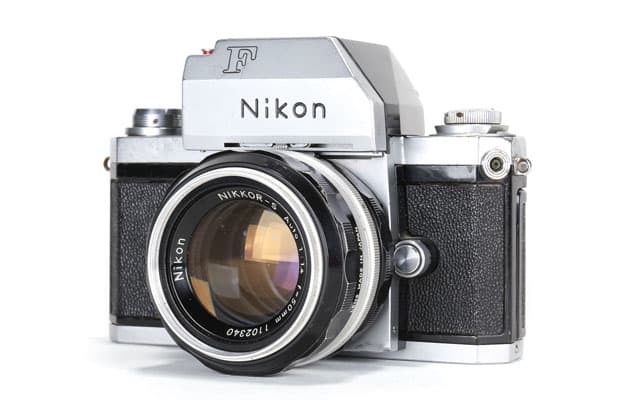Since AP published its first edition in 1884, photographic technology has changed beyond all recognition. Back then, photographers were using cameras constructed from wood and brass, and taking pictures on glass plates coated with light-sensitive emulsion. Since then, plates have given way to roll film and then cartridge film, before digital technology transformed image capture. Folding cameras have been superseded by fixed-body designs, rangefinders by SLRs, mechanical shutters by electronic, and manual focus by autofocus. Right now we’re in the middle of another big transition – from DSLR to mirrorless. All the way through, AP has been following and commenting on the trends of the day.
In this article we’ll be taking a look at how cameras have evolved and progressed over this time, by focusing on a few specific models. Some were trailblazers that debuted a particular feature or design approach, while others are classics that have became archetypes of their kind. Together they illustrate how we’ve progressed from cameras crafted from mahogany and brass through to the digital marvels we’re using today.

Sanderson full plate camera – ca. 1896
While this particular camera wasn’t made until a decade or more after AP’s birth, it’s still representative of what amateur photographers of the time might have used. This Sanderson ‘full plate’ model uses a classic folding-bellows design, and produces 8 1⁄2 x 6 1⁄2in exposures. The image would have been focused onto a ground-glass screen, which would then have been removed and replaced by a plate holder. The exposure times would generally have been in the order of seconds.
Cameras bearing Frederick Sanderson’s name were all based on a patent he filed in 1895, which describes a specific arrangement for holding the lens board using two pairs of slotted struts. Initially they were manufactured by Holmes Brothers in Manchester, before the firm was incorporated into the great British camera company Houghtons Ltd. Overall, about 27,000 Sanderson cameras were produced between 1896 and 1939.
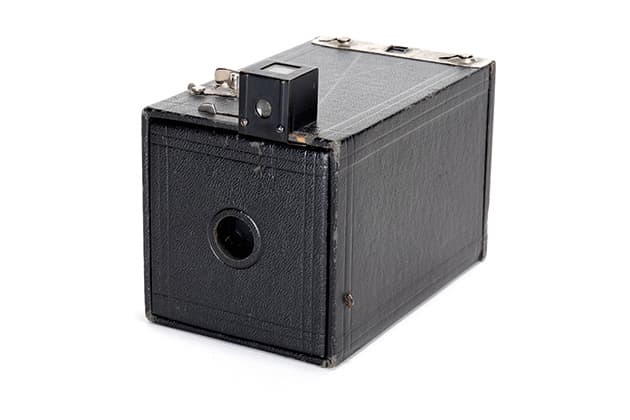
Kodak Brownie – 1900
While amateur photographers of the late Victorian era may have used big, complex, bulky cameras, the everyday snap-shooter wanted something smaller and simpler (sound familiar?). No company did more to deliver photography to the mass market than Kodak, and this was the first model to bear the famous ‘Brownie’ name. The original Kodak box camera of 1888 had come preloaded with a 100-exposure film, and needed to be returned intact to the factory for processing. But the Brownie used 117-format roll film that could be reloaded by the user, and cost just $1. It was hugely successful, with over 150,000 Brownies being made in the first year of production alone. The following year, the Brownie Number 2 adopted the larger 120-format film, which is still in use today. The Brownie name continued to be used on Kodak cameras all the way through to 1986.
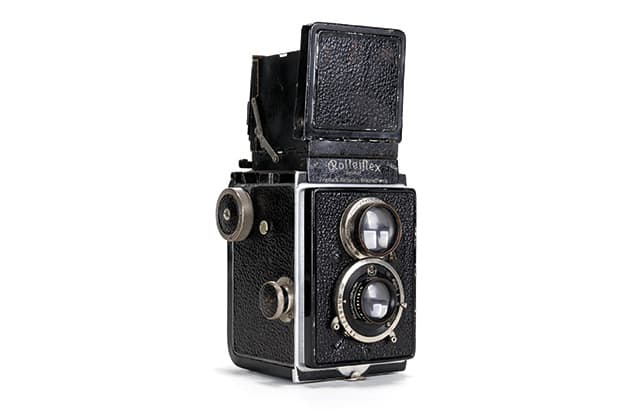
Rolleiflex – 1928
Early in the 20th century, a young designer with Voigtländer by the name of Reinhold Heidecke invented a twin-lens reflex (TLR) rollfilm camera. It solved the problem of focusing an image onto the film by using two linked lenses, one above the other, with the upper ‘viewing’ lens projecting an image onto a ground-glass focusing screen via a mirror. When the image on the screen was sharp, the film could be exposed in correct focus using the lower ‘taking’ lens.
Voigtländer wasn’t interested in Heidecke’s creation, so he formed his own company with businessman Paul Franke to build it. The resultant camera – the Rolleiflex – was the first production TLR, and through its many iterations became one of the most iconic cameras of all time. In our 3 April 1929 issue, AP described it as ‘a dainty and efficient camera, capable of doing first class work’.
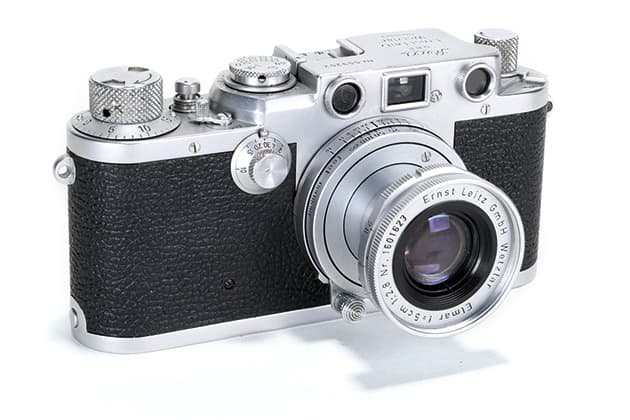
Leica III – 1933
In 1913, Oscar Barnack made the initial prototypes of his miniature camera that was the first to make practical use of 35mm cine film. Around 20 years later, the Leica III was released to great acclaim, with its major new feature being a slow-speed shutter dial allowing speeds as slow as 1 second. Suitably impressed, in our 28 June 1933 issue, we declared that ‘Leica has done its devotees a great service.’
While the Leica III is surely the great pre-war 35mm camera, it remained in production in its various iterations until 1960. This one is a post-war Leica IIIf, which itself came in sub-variants with different shutter speeds, and with or without a self-timer. The Leica’s small size and quiet shutter endeared it to a whole generation of candid photographers and photojournalists led by Henri Cartier-Bresson, and it was only with the emergence of high-quality Japanese cameras in the 1960s that their allegiance switched to SLRs.
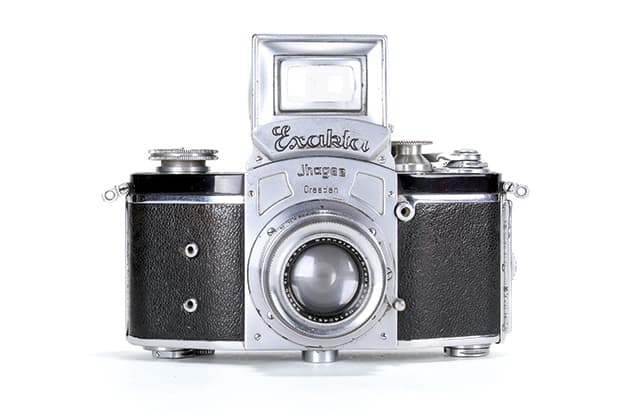
Kine Exakta – 1936
This bears the distinction of being the first truly successful 35mm SLR – a design approach that allowed the use of a much wider range of focal lengths than rangefinder cameras like the Leica. The image from the lens was reflected by a mirror to a waist-level hood viewfinder, with a powerful magnifier available to enlarge the image. AP’s reviewer marvelled at how this meant ‘the difficulty of accurate focusing with so small a picture has been completely overcome’ (AP 28 July 1937). When the shutter button was pressed, the mirror flipped up for the picture to be taken. Winding the film then reset the mirror and shutter for the next shot.
An extremely influential design, the Kine Exakta shot 36 24x36mm exposures on a roll of film. A focal-plane shutter offered speeds from 1/1,000sec down to 12sec, while a range of lenses was available up to 250mm. All told, some 80,000 were produced.
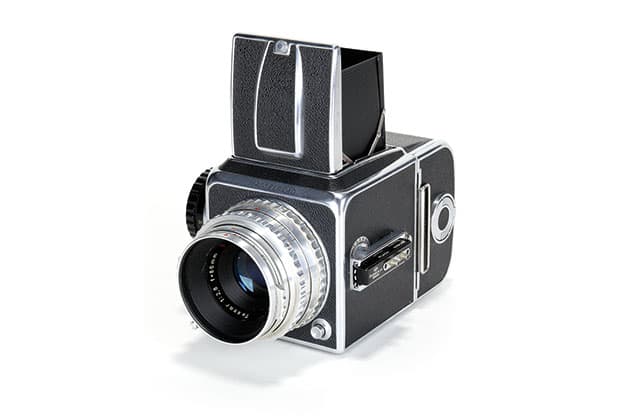
Hasselblad 1600F – 1948
While many photojournalists may have preferred the 35mm format, a huge proportion of professional and commercial photographers in the second half of the 20th century used a medium-format SLR as their everyday workhorse. None is more iconic than the Hasselblad: a camera whose modular design was so successful that it spawned numerous imitators.
Victor Hasselblad’s first creation, the 1600F sported interchangeable lenses, film magazines and viewfinders, and was named after its focal-plane shutter that offered a top speed of 1/1,600sec. In our initial assessment, AP declared it ‘by far the most advanced of its kind’. But the shutter proved troublesome, and in 1957 it was replaced by a leaf shutter incorporated into the lenses, to give the 500C. This model remained in continuous production for over 20 years, and remarkably its final variant, the 503CW, was only officially discontinued in 2013. Famously, NASA used highly modified Hasselblad 500Cs on its Apollo moon landing missions.
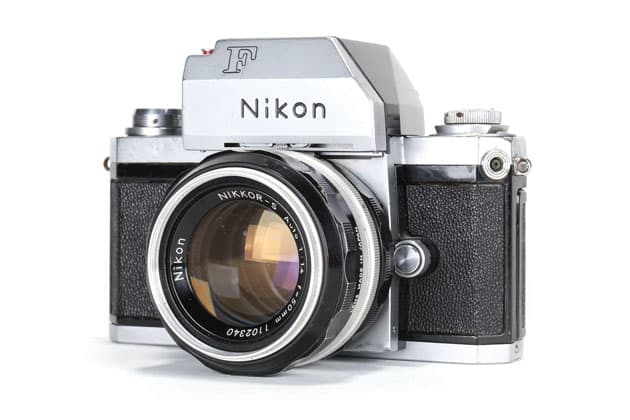
Nikon F – 1959
No listing of important and iconic cameras would be complete without mention of the Nikon F. This rugged, modular SLR became the centrepiece of the world’s most comprehensive professional 35mm system, and debuted the F mount that’s still in use by the firm’s DSLRs. It also heralded a shift from German to Japanese domination of the camera market that continues to this day.
While the camera had a rather basic mechanical body, Nikon released numerous accessories throughout its long life to meet the changing needs of professional photographers, including TTL metering heads and motordrives. Its ability to survive punishment was legendary; stories abound of the F surviving fires and monsoons, and even stopping bullets in Vietnam. The quality of Nikon’s optics was equally crucial in driving its acceptance by the most demanding photographers on the planet.

Rollei 35 – 1966
While serious photographers have always had a need for large, capable cameras with interchangeable lenses, they’ve also always craved high-quality small cameras to use alongside. This resulted in a wide range of sub-miniature formats, ranging from the 8x11mm negatives produced by Minox spy cameras, through to 18x24mm half- frame 35mm as employed by the original Olympus Pen. But then, just as now, smaller formats always meant compromising image quality. In 1966 Rollei overcame this problem with this remarkable little camera, still one of the smallest 35mm cameras ever made.
Designer Heinz Waaske employed a number of innovations to make the body so compact. The retractable Carl Zeiss Tessar 40mm f/3.5 lens was housed within a sliding tube, and a patented shutter design separated the blades in the lens from the clockwork that set the speeds, which was housed in the camera body. Both the shutter speeds and aperture were controlled via dials on the front of the body, with correct exposure indicated using a match-needle meter on the top-plate. This Rollei 35 T is identical to the original model, but renamed to distinguish it from later variants with different lenses.
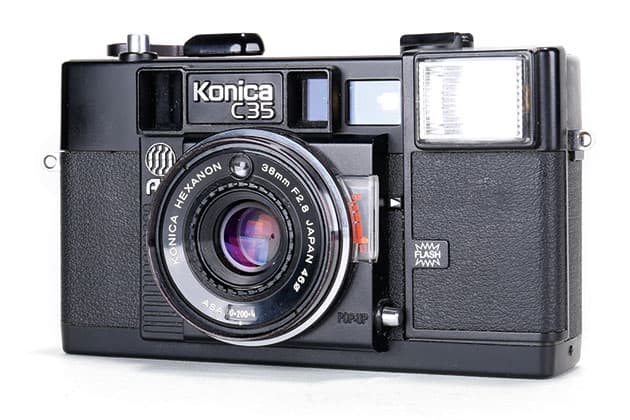
Konica C35 AF – 1977
Casual photographers have always desired automation to help with getting sharp, well-exposed images. Autoexposure systems were well established by the end of the 1960s, but the first camera capable of automatically focusing its lens was the Konica C35 AF. This unremarkable-looking 35mm compact employed the Honeywell Visitronic AF system, a form of passive autofocus conceptually similar to a coincident-image rangefinder. As if to reassure the photographer that the system was working, a small needle indicated the measured focus distance on a scale on the camera’s front.
Aside from this, the C35 AF was a pretty conventional 1970s 35mm compact. It used a 38mm f/2.8 Hexanon lens, with a CdS metering cell mounted above the front element inside the 46mm filter ring. Like most of its contemporaries, film wind-on was manual via a thumb lever, and the flash had to be activated manually. Two years later, Canon delivered a fully automated motor- wind camera, the AF35M.
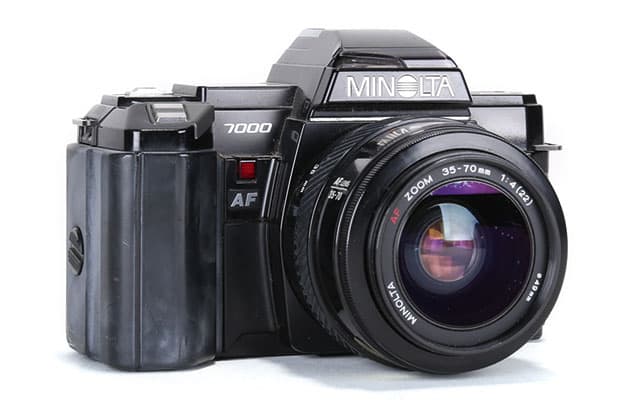
Minolta Dynax 7000 – 1985
Few cameras have had such an impact as this one: the first 35mm SLR with body-integral autofocus. Launched on an unsuspecting world in February 1985, it placed both the AF sensor and the focusing drive inside the camera body, resulting in a considerable size advantage compared to the primitive, bulky autofocus lenses that had come before. Minolta’s system was fast and accurate, added little bulk to the camera, and worked with a range of lenses even in total darkness (when coupled with a dedicated flash).
Photographers were hooked, while rival manufacturers were left to play catch-up. In our 2 February 1985 issue, we said, ‘Minolta’s new 7000 camera is set to herald a new generation of single lens reflex cameras.’ This turned out to be an accurate prediction with Canon, Nikon and Pentax all developing AF SLRs in quick succession, and manual-focus SLRs falling out of favour.
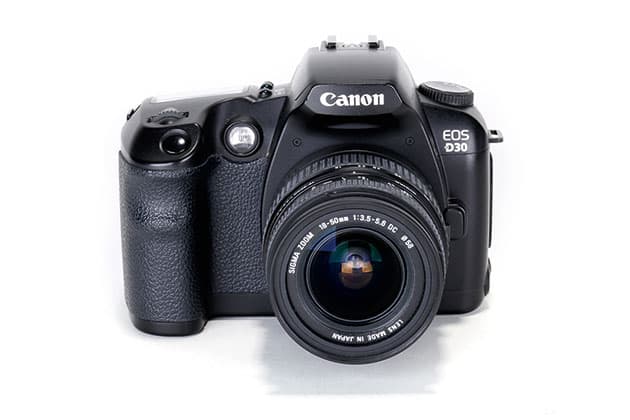
Canon EOS D30 – 2000
Canon was one of the trailblazers in the early days of digital imaging. The EOS D30 wasn’t the first ‘native’ DSLR made in-house by a camera manufacturer – that honour belongs to Nikon’s D1 the previous year – but it was the first whose sub-£2,000 price tag looked remotely affordable to enthusiasts.
Its specifications look measly now, with its 3-million-pixel CMOS sensor offering a maximum sensitivity of ISO 1600, and imposing a 1.6x field-of-view crop factor relative to 35mm film. It offered just 3 frames per second continuous shooting, and used a mediocre 3-point AF system borrowed from Canon’s consumer EOS SLRs. But even so, it showed that the future was going to belong to digital technology rather than film.
Three years later, Canon unveiled the first sub-£1,000 DSLR – the 6MP EOS 300D – and in 2005, it revealed the first affordable full-frame model in the shape of the 13MP EOS 5D. By this point it had already launched its last-ever film SLR, the EOS 300X.
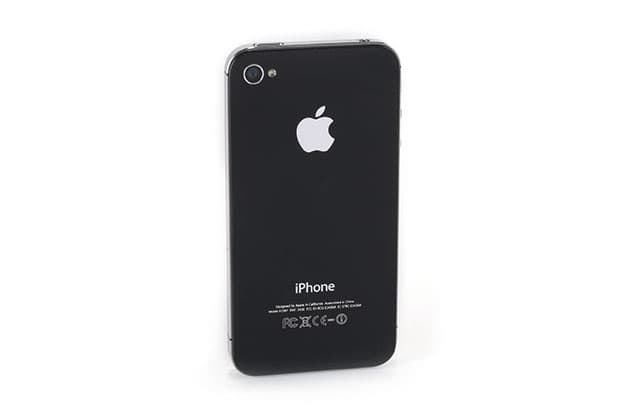
Apple iPhone – 2007
This may look out of place on a list of iconic cameras, but just as the Kodak Brownie was instrumental in the democratisation of photography in the early 20th century, so the iPhone drove its own, entirely digital revolution. Indeed it’s arguably the most important camera of this century so far. Where the Brownie allowed anyone to take photographs, the iPhone opened up the process to a hitherto unimagined degree. Freed from the need to print, it enabled users to share photographs instantly with anyone else in the world, thanks to social media apps such as Facebook and Instagram. But this could be achieved using a small, slim device that slipped easily into a shirt pocket or handbag. It decimated the point-and- shoot camera market in a matter of years.
Early iPhones had pretty poor cameras, and it’s debatable which model represents the tipping point where they delivered truly acceptable image quality. The 2011 iPhone 4S shown here is a strong candidate, thanks to its 8MP sensor, f/2.4 lens and Full HD video recording capability.
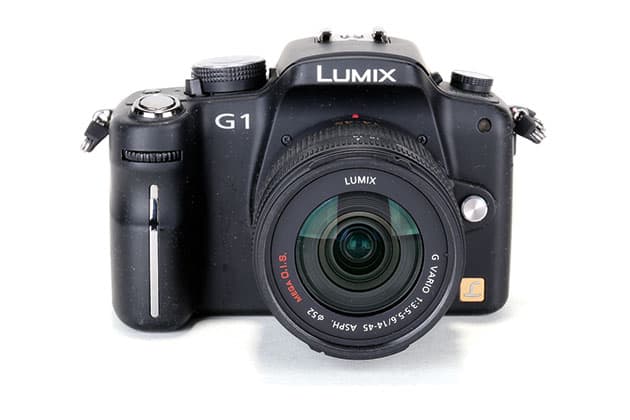
Panasonic Lumix G1 – 2008
It may be a most unremarkable-looking camera, but in terms of technology the G1 is just as important as any of the others in this article. It was the world’s first mirrorless interchangeable-lens camera – in other words, the first to use the main image sensor for autofocus, metering and full-time electronic viewing. This entirely digital architecture allowed Panasonic to dispense with the reflex mirror and make a considerably smaller, slimmer body compared to a DSLR.
The G1 wasn’t particularly acclaimed during its lifetime, in part due to its 12MP Four Thirds sensor offering unconvincing image quality compared to its APS-C DSLR peers. But it established a design template that’s since become a standard for high-end mirrorless cameras. With its central electronic viewfinder, fully articulated screen and extensive external controls, it built on the established SLR layout but also added a distinctly digital twist.

Fujifilm X-T3 – 2018
This brings us bang up-to-date, being typical of cameras used by enthusiast photographers today. Despite being carefully designed to look like a 1970s film SLR, in many ways it’s the archetypal modern electronic camera. Even the APS-C sensor size, measuring 23.5×15.6mm, is a uniquely digital format that was never employed by film cameras.
The mirrorless design enables a compact body with the kind of spec sheet we’d have found unimaginable a decade ago: 26.1MP resolution, 425 autofocus points, 20 frames per second shooting, and a top sensitivity of ISO 51,200. Along with the large, high- resolution electronic viewfinder, images can be composed using the rear touchscreen that tilts in three directions. Fujifilm’s large lens range covers focal lengths from 8mm to 400mm – equivalent to 12mm ultra-wideangle to 600mm super-telephoto. It seems a fair bet that those amateurs using Sanderson plate cameras a century ago would be jealous of where we are today.

